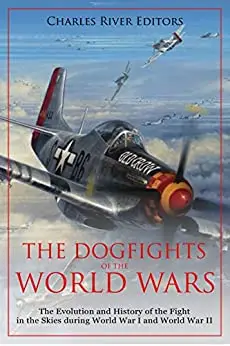The Dogfights of the World Wars: The Evolution and History of the Fight in the Skies during World War I and World War II by Charles River Editors
English | April 1, 2018 | ISBN: N/A | ASIN: B07BVJX66X | 103 pages | EPUB | 3.72 Mb
English | April 1, 2018 | ISBN: N/A | ASIN: B07BVJX66X | 103 pages | EPUB | 3.72 Mb
*Includes pictures
*Includes accounts of the fighting
*Includes online resources and a bibliography for further reading
*Includes a table of contents
The first aircraft to appear in the skies over the battlefields of World War I showed few signs of the dominant future of airplanes in warfare. Small, fragile, and slow, they provided no hint of the sleek jet fighters that would one day slash across the skies of Earth faster than sound to unleash the lethal blast and fire of sophisticated missiles, or the bombers able to level an entire city with one nuclear bomb. That said, they did not represent a complete novelty in warfare either, at least not during the early months of World War I.
While airplanes had never before appeared above the field of war, other aerial vehicles had already been in use for decades, and balloons had carried soldiers above the landscape for centuries to provide a high observation point superior to most geological features. The French used a balloon for this purpose at the Battle of Fleurus in 1794, and by the American Civil War, military hydrogen balloons saw frequent use, filled from wagons generating hydrogen from iron filings and sulfuric acid. The balloonist Thaddeus Lowe persuaded President Abraham Lincoln to use the airships for observation, communicating troop movements to the ground with a telegraph wire.
At first, airplane improvements occurred in an ad hoc, almost accidental manner during the war. However, when pilots’ mounting of armaments on airplanes proved a successful means of defeating other aircraft and even attacking men on the ground, a much more active and systematic development of warplanes began across the continent. Each advance prompted a countermeasure, as the two sides strove for primacy in a deadly, unforgiving environment which rewarded real advances in equipment and tactics with survival and punished poor ideas with death.
Before long, relatively powerful, heavily armed aircraft buzzed through the skies over battle-stained Europe, tearing each other apart with furious gusts of machine gun fire and sending many of the vaunted dirigibles plunging, burning, to the ground. The new era of fighting aircraft arrived in dramatic fashion, raising successful pilots to celebrity or heroic status, and laying the groundwork for the tremendous potential of airpower to achieve its next logical expansion in World War II and beyond.
By the time World War II arrived, the fighter airplane appeared as a much different beast than the purpose-built aircraft-hunting machines of 1917 and 1918. Though propellers still provided motive force, greatly increased engine power allowed these aircraft to slice through the sky at speeds of 200 mph, 300 mph, or even in excess of 400 mph when flying flat-out. Service ceilings jumped to 25,000 feet, 30,000 feet, or higher, altitudes unthinkable to World War I’s aviators. Engineering and research and development began working scientifically to shave time off the climb rate and address a host of other problems and possibilities.
At the start of the war, as the German Luftwaffe first flew against Poland and then the Royal Air Force, aircraft were already swift, metal-skinned hunter-killers in the sky, with enclosed cockpits, armor, and powerful loadouts of machine guns, 20mm cannons, and, soon, rockets. But an even bigger transformation awaited – the birth of the jet age, a future glimpsed briefly in the spectacular but doomed appearance of the Messerschmitt Me 262 near the war’s end.
The Dogfights of the World Wars: The Evolution and History of the Fight in the Skies during World War I and World War II looks at how technology and tactics evolved during the wars. Along with pictures of important people, places, and events, you will learn about dogfights like never before.
Feel Free to contact me for book requests, informations or feedbacks.
Without You And Your Support We Can’t Continue
Thanks For Buying Premium From My Links For Support
Without You And Your Support We Can’t Continue
Thanks For Buying Premium From My Links For Support



